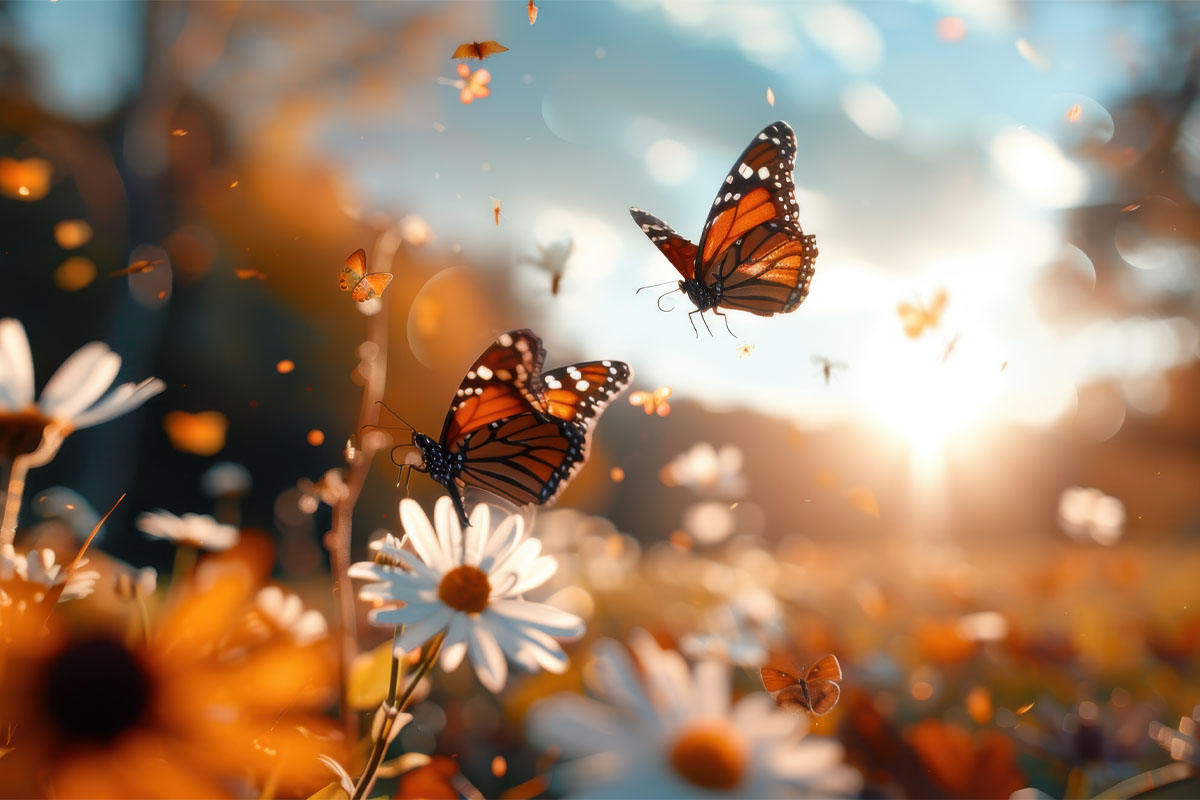HEADTURNED Articles
Nature is Broken
Given the chance, ecosystems can recover
Restoring Balance: A Call to Action
Introduction
In the 1970s, the countryside and cities alike were alive with the melodies of birds and the rustle of wildlife. Migratory birds like swallows and house martins painted the skies during their seasonal journeys, while sparrows, starlings, blackbirds, and song thrushes were a common sight in gardens, parks, and urban neighborhoods. Nature was not confined to remote forests; it was a vibrant, omnipresent force, enriching our lives. Fast forward to today, and that vibrant symphony has been reduced to a whisper. The countryside is eerily silent, the skies empty, and our urban landscapes devoid of the life that once thrived there.
What went wrong? How did we reach a point where biodiversity is crumbling, and entire species are on the brink of extinction? This is the story of nature's decline, and more importantly, it's a call to action to restore what we've lost.

Restoring Balance: A Call to Action
The Decline of Biodiversity
The statistics are staggering: global populations of wildlife have plummeted by over 60% in the past 50 years. Species that were once common are now endangered, their habitats decimated by human activity. Industrial agriculture, urban expansion, pollution, and climate change have created a perfect storm of destruction, leaving countless animals and plants struggling to survive.
Birds, often considered a barometer of ecological health, tell a sobering story. The cheerful sparrows that once nested in our eaves are now scarce. Starlings, with their mesmerising murmurations, have seen their numbers dwindle by over 80% in some regions. Blackbirds and song thrushes, whose songs once defined the mornings, are struggling to find food and safe nesting spaces. The skies that once hosted flocks of migratory birds are now disturbingly empty.
This decline is not limited to birds. Pollinators like bees and butterflies, essential for the survival of many crops and wild plants, are also in sharp decline. Mammals, reptiles, amphibians, and countless insect species face similar threats, leading to a chain reaction that disrupts entire ecosystems.
Restoring Balance: A Call to Action
The Roots of the Crisis
- Habitat Loss: Urban sprawl and industrial agriculture have replaced meadows, forests, and wetlands with concrete and monoculture crops, robbing wildlife of their homes.
- Pollution: Pesticides, plastics, and other pollutants poison the air, water, and soil, making it inhospitable for many species.
- Climate Change: Rising temperatures and erratic weather patterns disrupt migration, breeding, and feeding cycles, pushing species beyond their limits.
- Overexploitation: Unsustainable fishing, hunting, and deforestation have decimated populations of animals and plants.
- Lack of Awareness: A generation has grown up with diminished wildlife, unaware of the richness that once existed. For many young people, the sight of a hedgehog or a barn owl is a rare, almost mythical experience.
Restoring Balance: A Call to Action
A Broken System: Government's Failure to Protect Nature
Despite policies and legislations intended to safeguard nature, the UK government has fundamentally failed in its duty to protect biodiversity. While initiatives such as the creation of National Parks or conservation programs sound promising on paper, their implementation has been lackluster, and the results speak for themselves: the current state of biodiversity is a crisis.
Government actions have too often prioritised short-term economic gains over long-term environmental sustainability. For instance, relentless house building to address the population crunch has come at the cost of green spaces, ancient woodlands, and habitats vital for wildlife. Instead of integrating biodiversity considerations into urban planning, construction projects bulldoze through ecosystems, leaving sterile, concrete landscapes in their wake. This narrow focus on immediate development objectives exacerbates the destruction and extinction of countless species—and humanity is not exempt from this chain reaction.
Pollution regulations have proven insufficient to curb the poisoning of our rivers, air, and soil. Agricultural policies still permit the widespread use of pesticides that decimate pollinators and beneficial insects. Meanwhile, climate goals are continuously undermined by slow implementation and loopholes that allow industries to operate with impunity.
The lack of understanding and urgency is self-evident. If government policies were effective, we wouldn't be witnessing the silent parks, barren fields, and declining wildlife that are now the norm. Visit a park today, and you'll find emptiness where vibrant birdlife once thrived. Look to the skies, and they're devoid of the migratory flocks that Sir David Attenborough's documentaries celebrated for decades.
It's not enough to tweak existing systems. The current practices are broken and unfit for purpose. The government must overhaul its approach to biodiversity with immediate urgency. A redesigned infrastructure must prioritise:
- Habitat Protection: Enforce stricter regulations to prevent the destruction of natural habitats during development projects.
- Investment in Restoration: Fund large-scale rewilding and afforestation programs to restore ecosystems.
- Sustainable Agriculture: Support farmers in transitioning to pesticide-free, biodiversity-friendly practices.
- Public Engagement: Launch national campaigns to educate and inspire public to value and protect nature.
- Climate Resilience: Integrate biodiversity goals with climate action plans to ensure a holistic approach.
The alternative is unthinkable. If the government persists.
Restoring Balance: A Call to Action
The Emotional Toll
Imagine the despair of a child who never hears the joyous melody of a skylark, never marvels at the vibrant dance of a butterfly against a summer sky. For that child, nature exists only in books and screens, a distant and fading memory of what life once was. Now, think of the elderly gardener, whose hands have nurtured the soil for decades, who remembers when their backyard teemed with life—a symphony of chirping sparrows, flitting dragonflies, and the soft rustle of hedgehogs at dusk. Their silent anguish reflects the loss of more than just wildlife; it's a loss of connection, joy, and identity.
The tragedy deepens with the younger generation, growing up in a world where emptiness in wildlife has become the norm. For them, the absence of birdsong in the morning or the sight of deer grazing near urban edges is not a cause for alarm—it's simply the way things are. They've never known the wonder of thousands of starlings in a murmuration, nor the thrill of spotting a badger crossing a quiet country lane. For these children, nature has been relegated to rural sanctuaries or nature documentaries, a far cry from the daily presence it once held in towns and cities alike.
The last 30 years have seen a catastrophic decline in biodiversity—a tragedy that most of today's youth cannot fully grasp because they never experienced what has been lost. The vibrant ecosystems that were once part of everyday life have been replaced by sterile urban landscapes and fragmented habitats. The sparrows that thrived in city eaves, the butterflies that painted gardens in living colour, the toads that croaked from neighborhood ponds—gone, or nearly so.
A Loss That Cuts Deep
This loss isn't just ecological; it’s deeply personal and cultural. Nature has always been a source of inspiration, solace, and grounding for humanity. It's where children learn curiosity and wonder, where adults find peace, and where cultures have drawn meaning and stories for generations. Without it, there's a void that no amount of technology or urban innovation can fill.
The absence of wildlife also diminishes our shared history. Stories of watching the first swallows of summer return or catching fireflies on warm evenings now sound like tales from a bygone era. These experiences were once universal, bonding generations with a shared connection to the natural world. Their loss signals not just the decline of nature but the erosion of an essential part of human life.
Turning the Tide: Bringing Wildlife Back
Let's commit to making the extraordinary ordinary once again. Let's ensure that children can wake up to a dawn chorus, that butterflies once more dance through summer air, and that future generations marvel at the natural world not through screens, but in their daily lives. Together, we can bring life back to our empty landscapes. Together, we can make nature thrive once more.
Restoring Balance: A Call to Action
A Positive Solution
The good news is that nature is resilient. Given the chance, ecosystems can recover, and species can rebound. But this requires collective effort—from individuals, communities, organisations, and governments. Here's how we can help:
Create Wildlife-Friendly Spaces
Transform gardens, balconies, and public spaces into sanctuaries for wildlife. Plant native flowers, install birdhouses, and provide water sources.
Remove Pesticide Use
Advocate for and adopt organic practices that protect pollinators and other beneficial creatures.
Support Conservation Efforts
Donate to organisations like the HEADTURNED Foundation, which are working tirelessly to restore habitats and promote biodiversity.
Spread Awareness
Use social media to share the urgency of this crisis. Encourage friends and family to join the movement to restore nature.
Engage in Public Science
Participate in projects that monitor wildlife, such as bird counts or butterfly surveys, to contribute valuable data for conservation efforts.
Restoring Balance: A Call to Action
The Results We Can Achieve
With a united and sustained effort, we can create a future where nature is no longer on the brink but flourishing across every corner of the UK. Imagine urban neighborhoods transformed into vibrant ecosystems, where green corridors connect parks, gardens, and public spaces, providing sanctuary for birds, mammals, and pollinators. Picture rural landscapes teeming with life, from the hum of bees pollinating wildflowers to the sight of native deer grazing at dawn.
Restoring Urban and Rural Habitats
By reinvesting in green spaces, both urban and rural, we can rebuild habitats for countless species. Community initiatives, such as planting native hedgerows or creating ponds, can provide essential resources for wildlife to thrive. Public parks can become rich ecosystems instead of lifeless lawns, drawing wildlife back to our towns and cities.
Reintroducing Native Species
With careful planning and support, species that have vanished or are critically endangered can return. Beavers are being reintroduced to counties across the UK after 400 years of extinction, and a keystone species that transforms waterways, while wildflower meadows can host butterflies and bees. These species don't just enrich the landscape; they also play crucial roles in maintaining healthy ecosystems.
Inspiring Future Generations
Education and engagement are key. By showing children the wonders of nature through firsthand experiences, we can instill a sense of awe and responsibility. School programs, wildlife clubs, and family-friendly conservation projects can create a generation passionate about protecting the natural world.
Building a Legacy of Biodiversity
Every action taken today contributes to a long-lasting impact. Restoring biodiversity creates healthier environments for humans and wildlife alike. Cleaner air, richer soils, and balanced ecosystems benefit everyone, fostering resilience against climate change and ensuring sustainable futures.
This journey starts with you. By joining forces, we can reverse the decline of wildlife and bring back the harmony of nature. Let's turn our shared vision into reality—ensuring that every living creature, from the tiniest insect to the most majestic bird, has a safe and thriving home. Together, we can transform emptiness into abundance, proving that humanity and nature can not only coexist but thrive side by side.
Restoring Balance: A Call to Action
Call to Action
We need everyone's help to reverse this trend. Share the mission of the HEADTURNED Foundation across your networks. Make a donation, sponsor essential tools, equipment, or land, and volunteer your time to create wildlife havens in your community. Together, we can rebuild thriving ecosystems.
Imagine a future where sparrows once again chirp from urban rooftops, where children marvel at the sight of deer grazing near their schools, and where migratory birds once again grace our skies in their millions. This isn't just a dream—it's a potential reality, achievable if we act now.
